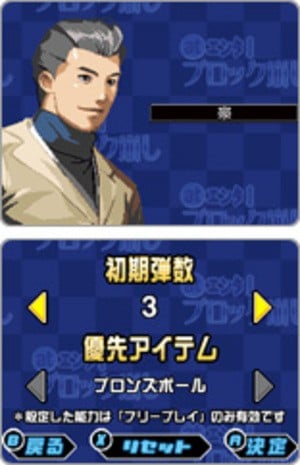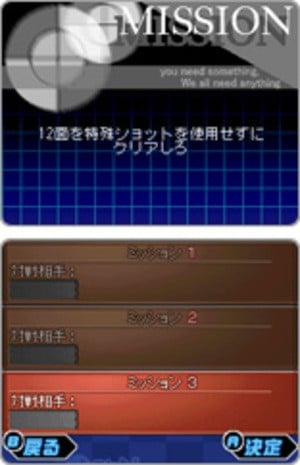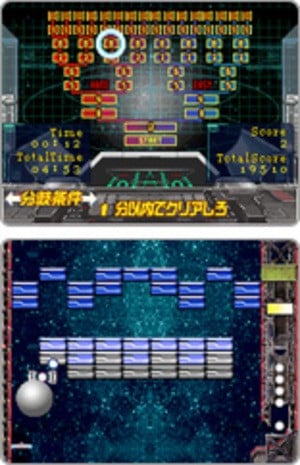
Tasuke seems to have been putting out a lot of board game titles recently, which all seem to be broken out from a retail release called Table Game Spirits: Victory; which is itself an enhanced version of Table Game Spirits. Both of them are Japanese DS cart releases that collect various Japanese board games including shogi, go, mahjong and hanafuda, as well as Western card games, air hockey, darts, sliding puzzles and block kuzushi, which is what Breakout, Arkanoid and their ilk are generically known as in Japan. Although knowing the source of this game would seem to put it squarely in the "mini-game" category, it's actually a pretty decent game in its own right rather than just another Arkanoid clone.
As with other games in the series, you have a choice of two modes: Free Play and Challenge. Free Play gives you a choice of eight characters you'll recognise from other games in the series and then a collection of rules to set (all in Japanese, of course) governing things like whether or not power-ups appear at all and if they do appear, whether or not to restrict certain types, such as the special ball that fires lasers. You then get to play through a progression of boards of increasing difficulty. Challenge Mode sees you taking on a total of 18 different "missions" grouped in five levels of three each, with unlocking of subsequent levels being dependent upon clearing all the missions of the preceding level. The ultimate goal of Challenge Mode is to uncover all the pieces of a picture (which appears to be an anime-style drawing of your veiled character, possibly?), but mostly it gives you something to work towards with fixed rules in place for each mission that will become apparent – assuming you cannot read Japanese – by your game ending when you violate any of them.

Putting a breakout-style game on the DS can be a tricky business. Whilst it may seem logical to use both screens for the play area, in a fast-paced game of breakout having the ball cross between screens can be a game-breakingly bad idea, so Tasuke was wise to have the gameplay take place in the bottom screen whilst your score and level progression are displayed in the top. Although we would have preferred the analogue precision of stylus input in this game, having all the action in the lower screen would make it impossible to implement this without your stylus (and hand) obstructing play. Using the D-Pad, though a little clunkier, is clearly the best choice for paddle movement. If you need the paddle to move faster once the ball starts speeding up you need to hold the Y button – it's not ideal, but workable.
Ball physics feels a little strange compared to a normal breakout game, but that's probably because this game allows players to tilt the paddle at up to a 30-degree angle left or right using the shoulder buttons rather than having some part of what is otherwise a flat plane cause the ball to bounce at a different angle. This "more realistic" physics means a little adjusting of play style is required, but it also gives you more control over the direction of the ball since you can actually "push" it in the direction you want it to go; unlike most games of this type where you can easily bounce a ball around endlessly trying to hit that last brick.

Normally a breakout game just uses a single knob controller and a button to launch the ball or trigger power-ups, but at Enter! Block Kuzushi uses every button on the DS, replacing many functions that would normally be power-ups in Arkanoid with user-triggered actions. The only power-ups that exist are paddle widening/shortening ones and special balls. Rather than falling down the screen, the power-ups stay in place and only register when struck by your ball – this has the dual effect of denying players easy access to them, but also providing the possibility of avoiding a "bad" one.
Only one of the special balls comes into play automatically: the others get stored in a reserve you can access at any time, pressing X to change the ball order and A to launch them in succession. If you want to play with multiple balls on screen simply press the A button as many times as you like, but bear in mind that you'll need to find more or score well enough to earn an extra one, and some of the missions end if you lose more than one.
One other item in your paddle's arsenal is the ability to power-up a ball bounce to break through multiple bricks. As you break bricks a power-gauge fills up; once full it flashes indicating you can power-up a ball by pressing B when it hits your paddle. This is a single use effect and sends the ball blazing through multiple bricks, however if it hits any brick that requires multiple hits to break it will come screaming back at you, so you'll need to be cautious about using it. There are also several missions that will end your game if you try to bounce the ball in this way.
For 200 Points, it's actually a pretty good game of Breakout. By giving players control over the orientation of the paddle and triggering of actions that would normally be random power-ups, at Enter! Block Kuzushi adds a strategic element that would otherwise not be present in this kind of game, adding another dimension to play. If you have a Japanese DSi and enjoy brick-breaking games, it's definitely worth checking out. If you don't have a Japanese DSi and you're interested in this or other games in the "at Enter!" series we'd suggest trying to import one of the titles mentioned above as they seem to offer a pretty wide selection of games you're unlikely to find outside of Japan.
Comments 4
"this game allows players to tilt the paddle at up to a 30-degree angle left or right using the shoulder buttons rather than having some part of what is otherwise a flat plane cause the ball to bounce at a different angle [...] it also gives you more control over the direction of the ball since you can actually "push" it in the direction you want it to go; unlike most games of this type where you can easily bounce a ball around endlessly trying to hit that last brick."
I don't get how this is the first game in this genre—that I've heard of, anyway—to allow you to tilt the paddle. One of the most frustrating things about brick breaking games is having to jerk around for a few minutes because you can't get rid of that last damn brick!
Nice article, Sean...
Is it better than AlphaBounce?
its BreakOut with missions!
Metroid Fan: Name another. I've never encountered this control before.
Tap here to load 4 comments
Leave A Comment
Hold on there, you need to login to post a comment...